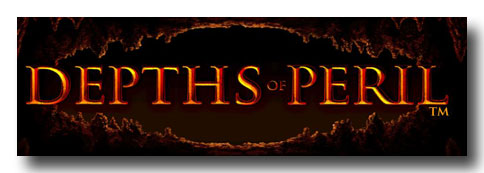
Depths of Peril is unlike any other game out there. This makes its obscurity all the more discouraging. For all the gamer complaints about “Me Too!” game designs, most would still rather bide their time waiting for, say, Diablo III than try something different. Depths of Peril may be no Diablo III but it’s much more interesting than Blizzard’s polished, safe and bland designs.
How best to describe this unusual 2007 game? A single-player Diablo for the MMO generation might be one way. You start with Diablo then tack on MMO-inspired elements like guilds and GvG, and let everything play out in a game world filled with creatures pursuing their own objectives. Somehow all this ambition fits in a game that takes up a mere 100MB of hard disk space.
This is all the more remarkable an achievement since the game was released by an indie developer with only one full-time employee. Soldak Entertainment didn’t have much money to pour into its debut title and it shows. Depths of Peril makes a poor first impression. The game looks middling, the spell effects are sometimes laughable and the animation is often several frames short of smoothness. While it’s certainly not a terrible eyesore, it’s not going to win any best of show awards for presentation.
Depths of Peril may have had a low budget but it’s undeniably rich in gameplay. Interesting ideas, major and minor, abound in this game. While these aren’t always executed flawlessly, the game is rarely uninteresting.
Guild wars
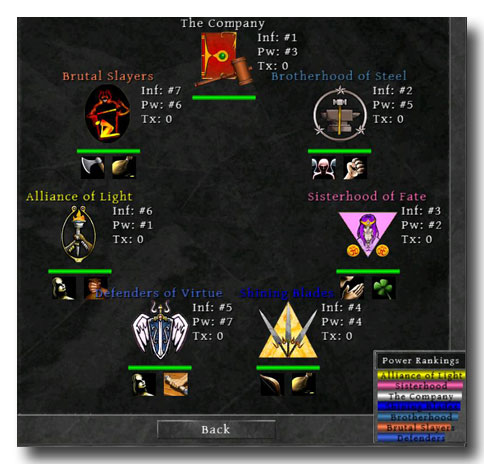
Depths of Peril has two major features that elevate it above other Diablo-likes.
The first is covenants, NPC guilds which vie with the player’s own covenant for prestige and power in the village of Jorvik. You will see members of other covenants out in the wild slaying beasts as you do, completing quests as you do and recruiting new members as you do.
Prospective recruits can be found in two ways. Some wander in the wild and these must be quickly enlisted before they fall victim to beasts. The better prospects will present themselves in Jorvik and announce their availability to all and sundry. Prove your worth and they will boost your ranks, adding to the power of your covenant; dally and they might end up joining your rivals.
You are free to deal with other covenants as you see fit. To facilitate this, the game provides enough diplomatic options to make covenant relations interesting. You can carry out trade, placate the powerful, boss the weak and ally with the worthy.
Reigning supreme in Jorvik will ultimately require defeating all covenants opposed to you. This can be achieved either through a victorious alliance or by being the last covenant standing.
Defeating a covenant entails invading its house, dealing with its defenders and destroying its lifestone. Clearly meant to be the centrepiece of the game, these raids regularly feature over a dozen combatants tightly compressed in a small space around a covenant lifestone.
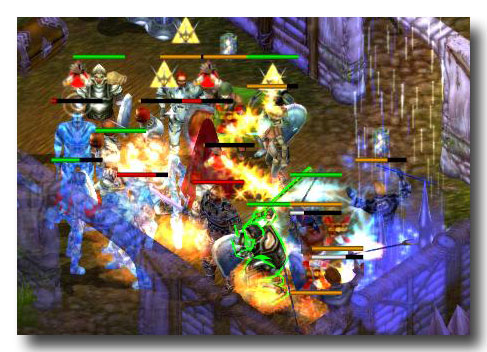
(Here then is the most likely reason why the graphics and animation have been simplified: more polygons and animation would have resulted in dramatic slowdowns for modest systems during raids and it should be noted Depths of Peril has very modest system requirements indeed.)
If covenant raids sound grand and spectacular in theory, they play out awkwardly in reality. These wild, chaotic and overlong scrimmages are less about tactical acumen and are more about outlasting your opponents. Friend and foe will die multiple times, often not knowing what hit them or who.
Hackenslasher
Taken at face value, the action aspect of this action RPG, which comprises the bulk of the experience, is nothing spectacular.
The quests are certainly straightforward and unremarkable with the objectives invariably being deliver this, kill that, escort her, gather those and rescue him. There is a storyline but keeping track of details beyond quest objectives is a difficult task what with all else that’s going on. Upon completion of the storyline, there is no fanfare or sense of closure. You simply cycle through the same storyline quests again.
The combat feels just as repetitive. Tactically rudimentary, combat in the game is all about managing aggro, auto-attacking, building up power to unleash special abilities and waiting out cooldowns. It’s very MMO-like.
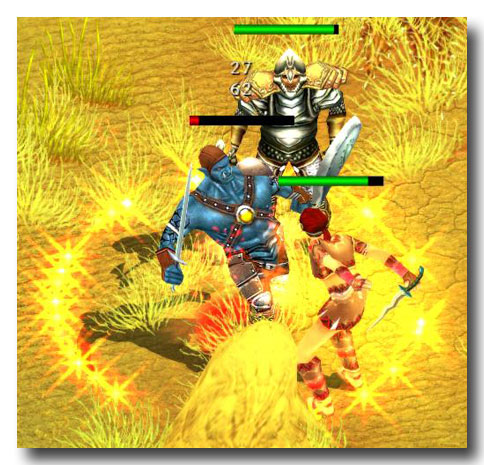
Still, there are thoughtful little touches in this game that only a long-time hackenslasher would appreciate. Take the town vendor, for example. In Depths of Peril, the player is able to reserve uncommon items for later purchase or, in case of seller’s remorse, purchase the last two goods sold for the selling price.
Other little touches only serve to exasperate. Item management can be especially annoying in the beginning. Bags and sacks must be purchased or found before items can be stored in stashes. The need to identify items seems a wholly unnecessary attempt to delay gratification. It would be understandable in an MMO whose whole point is to slow the pace down to wheedle another month’s worth of fees out of you; it’s less forgivable in a single-player game. The player may pay the town vendor to identify items but what little money the player makes is best invested in items for self-preservation.
This is an unapologetically a hardcore game with hardcore rules. Death comes frequently and incurs a penalty in the form of XP debt. Until you work off that debt, you gain less experience than usual. To reduce the amount of XP debt, you may return to the spot where you were slain to retrieve your soulstone. However, the beasts that slew you will still likely be there which means you might accrue additional XP debt.
To mitigate the difficulty, you may take along one of your covenant recruits while adventuring. This NPC ally can be equipped with new weapons and armour, and will gain experience as you do. Though this sidekick will have a nasty habit of engaging any and all foes within aggro range even when you’d rather not, he or she will be more a welcome asset than a hindrance on the whole.
Those looking for an even stiffer challenge can unlock game modes with permadeath and/or without NPC allies. The more cautious player should keep the game at its default difficulty settings until the intricacies of the game world are better understood.
Quest and consequence
If the action aspect of this action RPG is mostly unremarkable, the dynamic game world that the action takes place in is nothing short of extraordinary. This is the second feature that elevates Depths of Peril above other Diablo-likes and the feature that sets it apart from most games. All games account for player action but few games show the consequences of player inaction as this one does.
The creatures in the game do not twiddle their digits waiting patiently for the player to make an appearance because even they have their own agendas. Neglect to stop an advance scout and you may find yourself dealing with an invasion of Jorvik. Fail to stop a boss creature and it may incite an uprising, turning an area of the game into a deathtrap, which in turn dynamically generates a new quest to reduce the danger.
Even after hours of play, expect the game to produce the unexpected. You may walk into Jorvik hoping to dispose of looted treasures only to find the town vendor has been petrified. The town’s water supply may be poisoned causing the prices of food items to shoot up. The Cobra Nagas might decide to bombard Jorvik with Siege Towers set up outside the village’s walls.
The dynamism and unpredictability of the game world is the single best thing about Depths of Peril but it will take a while to fully appreciate how remarkable an achievement it really is.
The bottom line
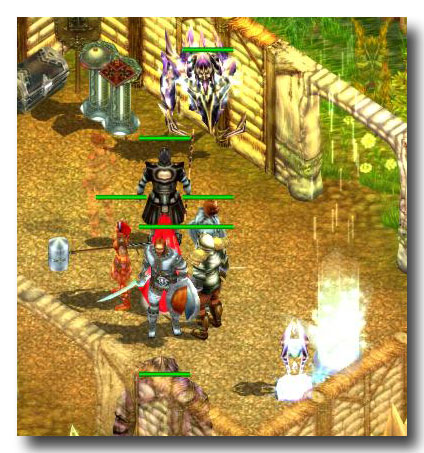
Soldak Entertainment deserves plenty of kudos for infusing its Diablo-like with a lot of new ideas but the problem is there may be too much game here. The player is given four goals to achieve in Depths of Peril: gain personal power, improve the covenant, deal with other covenants and help out the town.
All agendas can sometimes converge — by helping out the town, you can level up your character and one-up other covenants — but, for the most part, the player will be regularly distracted from current tasks by other matters that need to be dealt with urgently. The town steward may want a package delivered as you’re busy exploring a dungeon; an attempt to complete a quest might be aborted by an unexpected covenant raid; a trade demand may occur while you’re in pitched battle with a boss.
Though ambition is always to be applauded, Depths of Peril may have benefitted from a smaller scope and a more focused design. As it turns out, that’s exactly what Soldak is doing with its latest title, Din’s Curse. Currently in beta, the game might very well be Soldak’s breakout title. The jaded hackenslasher would be well advised to keep an eye on Soldak because there’s nothing quite like Depths of Peril and it will be interesting to see what this little developer with grand ideas has learnt in the two years since its release.
